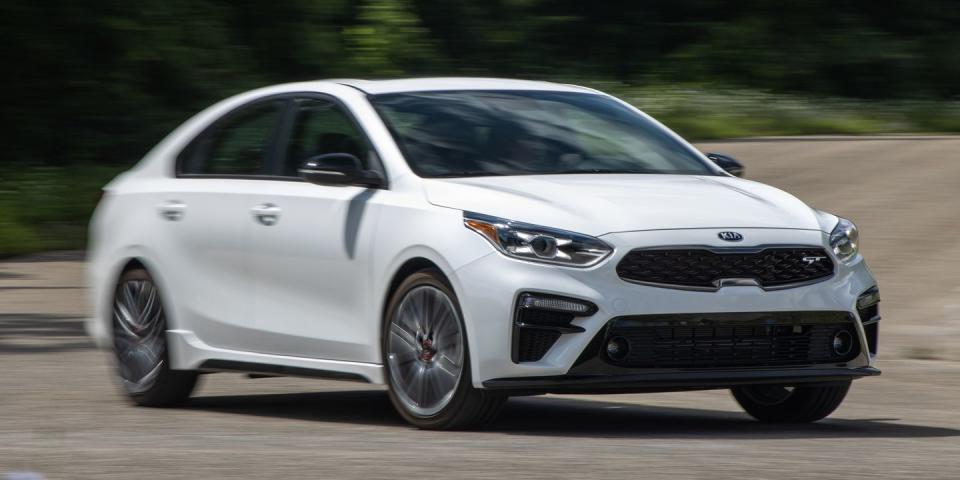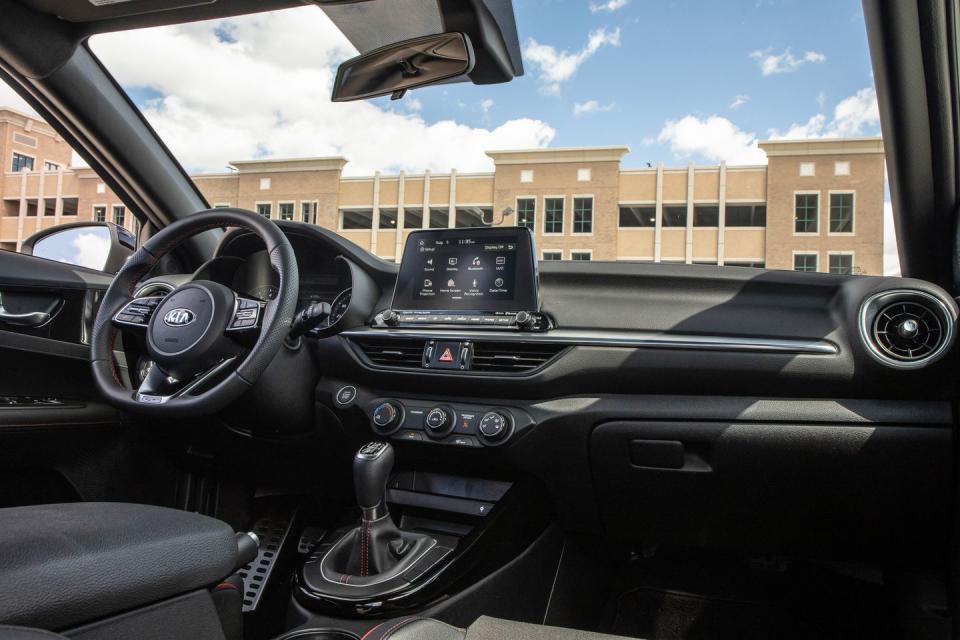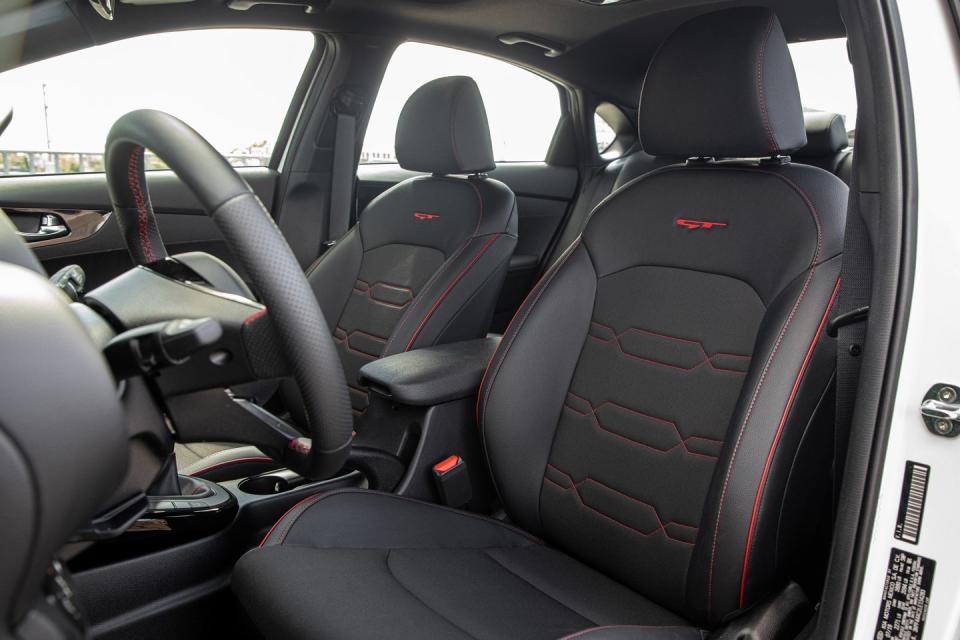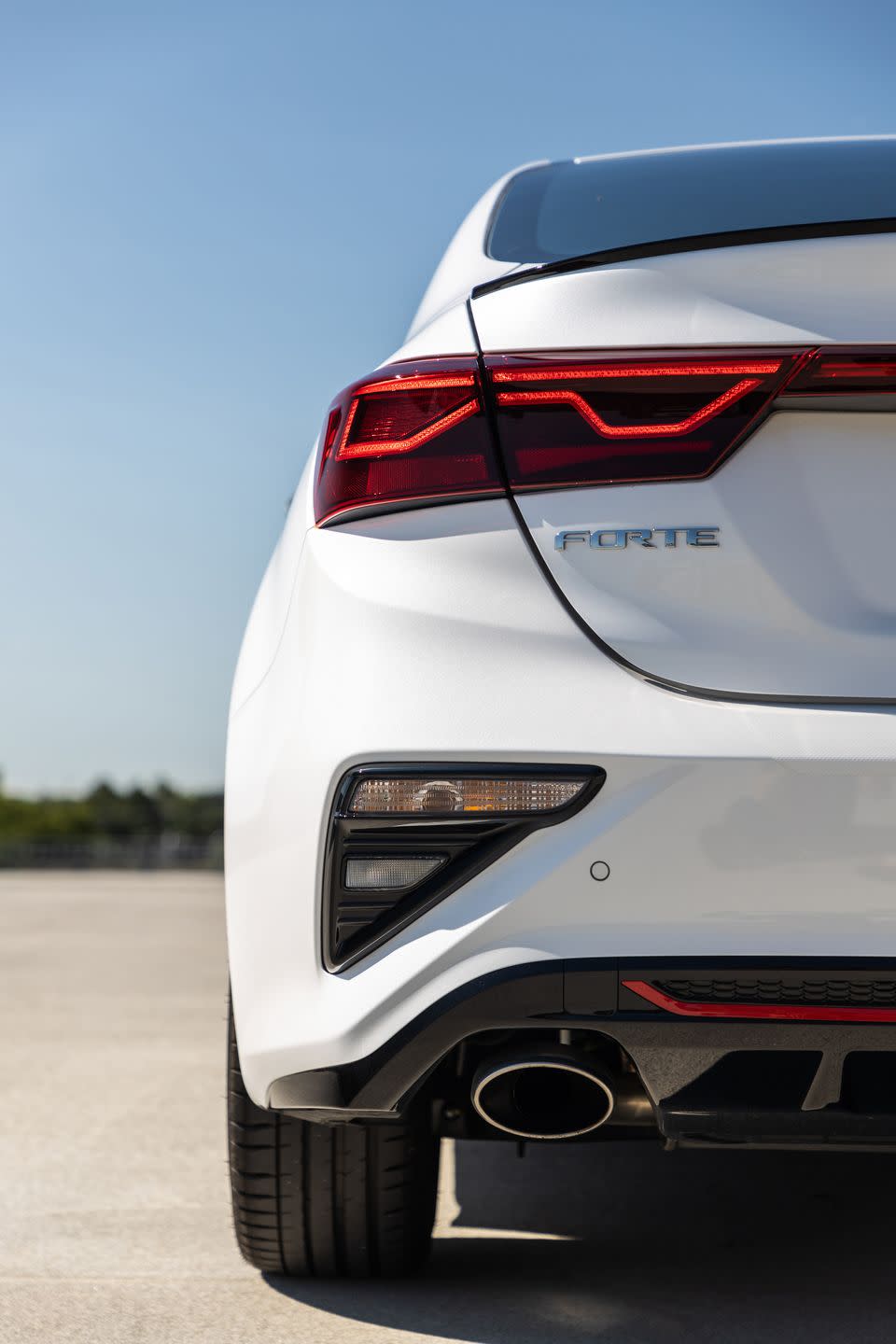Tested: 2020 Kia Forte GT Puts Value Ahead of Sportiness

The ophthalmologist's assistant, masked for COVID-19 protection, handed my repaired glasses through the driver's-side window of the Kia Forte GT and stepped back to take in the white compact sedan. "I'm looking to buy a new car, something sporty," she said, shaking her head in approval. "What is this?"
It's easy to see why it took her but one glance to pick up on the Forte GT's vibe. With its blacked-out trim and aggressive front end, low-profile Michelin Pilot Sport 4 summer tires wrapped around racy 18-inch alloy wheels, and subtle rear deck spoiler that looks borrowed from a BMW M2, the GT comes across as purposeful and, yes, sporty. The GT's appearance does not bring to mind a SpaceX rocket or an IMSA race car. Rather, it's a more conservative, classic look, one that you'll find on two other well-known, front-wheel-drive sports sedans: the Honda Civic Si and Volkswagen Jetta GLI—which are, in fact, the Forte GT's direct competitors.

The GT was added to the Forte lineup for the 2020 model year. Fitted with the same 201-hp turbocharged 1.6-liter four-cylinder engine found in many Hyundai and Kia products, plus a six-speed manual transmission and a firmer suspension, the Forte GT's spec sheet lines up well against the 205-hp Honda and the 228-hp VW. Kia even went to the trouble of swapping the Forte's standard torsion-beam rear axle for a more sophisticated multilink setup to improve the GT's handling. We'll soon toss it into a face-off against the GLI and Si in a comparison test to see how well these changes work.
It will enter that competition with at least one great strength: value. The GT is similarly equipped to both the Honda and VW, but its base price undercuts the former by $1580 and the latter by $2615. You do have to pony up an extra $200 for our test car's 225/40R-18 Michelin Pilot Sport 4s—summer rubber is also $200 on the Si but included at no cost on the GLI—but the rest of the GT's gear is standard.

The treatment starts with an interior that's dressed in more soft surfaces and less hard plastic than you'd expect in a hot-rodded economy sedan. The front buckets are good looking, deeply pocketed, and covered in grippy fabric and leatherette. The steering wheel is an appropriately sporty, leather-covered flat-bottom design. An analog tach and speedo housed in round white-on-black gauges stare back at you. Above your head is a power moonroof, and the premium audio system is from Harman/Kardon. Our example did have one other option, Snow White Pearl paint ($295), plus a few accessory add-ons such as a cargo mat and net and wheel locks but still came in at just $25,090. If you'd prefer your GT with a paddle-shifted seven-speed dual-clutch automatic, it'll reduce the bottom line by $600.
Our initial impression of the GT is that it delivers much of the sportiness that its looks promise—to a point. Its test-track results overlap that of its main competition, with a zero-to-60-mph time of 6.7 seconds, skidpad grip of 0.93 g, and a 157-foot stop from 70 mph. That's enough to keep this Kia interesting in most daily driving situations. And although we averaged a reasonable 27 mpg in our regular, spirited driving cycle, the GT's 37-mpg return on our 75-mph highway fuel-economy test is a whopping 5 mpg better than its EPA estimate.

But fun behind the wheel is about more than just numbers. It's about the feel and confidence that the car imparts through its primary controls, the sounds that its engine makes, and the connection between the driver's inputs and the car's responses. Driven briskly, the GT feels lively and athletic. The clutch pedal is light and easy to modulate, and the shifter moves through its gates with little effort. The GT's steering is accurate, its brakes reasonably responsive, and its ride motions clipped but not overly harsh. Through the first half of the tachometer's sweep, the exhaust snarls distantly.
Press the Forte GT hard, though, and its composure unravels. Steering feel evaporates. Storming out of tight second-gear bends demands a delicate touch on the throttle lest the inside front tire spins and howls futilely. Slashing around an off-ramp brings subtle interference from the stability-control system even if you've turned it off. The chassis loses the crisp edge and taut body control it has in less-aggressive driving. The exhaust's pleasant snort morphs into a generic four-cylinder thrum as the 1.6-liter's revs climb above 4500 rpm.

This is the low-percentage end of the driving spectrum to be sure, but the best cars in this segment happily hang out there. They have the chops to stay collected, confident, and playful right up to the point where the grip runs out and the tach needle hits the red zone. The Forte GT is almost there but not quite.
Which is not to say the Forte GT fails as a compact sports sedan. It looks the part, has adequate room inside, and is engaging to drive. Factor in an impressive roster of standard equipment that helps make it a terrific value, and it's got a lot to offer buyers searching for a sporty economy car. It's just not quite talented enough to win us over.
You Might Also Like

 Yahoo Autos
Yahoo Autos 